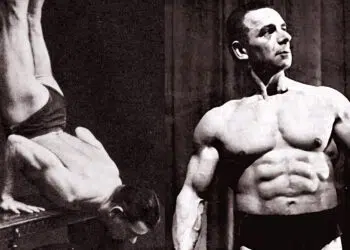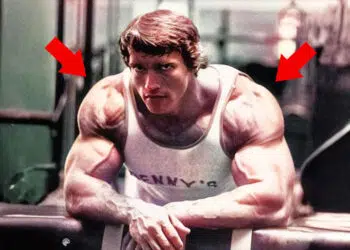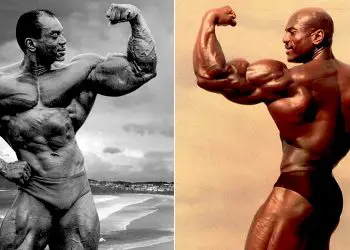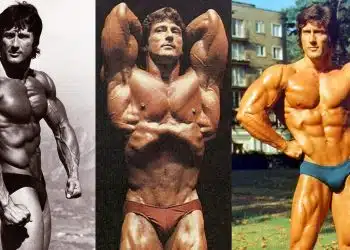Of all the muscles in the human body, the calves are one of the hardest to develop. They have a reputation for being stubborn, and a lot of people believe that they can’t add mass to this crucial muscle group.
But, if you look back at the golden age of bodybuilding, you’ll see that many of the champions of the day had great calves. They didn’t moan about bad genetics or worry about overtraining. Instead, they just worked their calves hard and often. The result? Big calves were as common as big biceps.
Don’t hide your calves under long sweatpants. Build lower legs you can be proud of with these proven and best old-school calf workouts.
Calf Anatomy 101
For such a small muscle group, your calves are surprisingly complex. They are actually made up of two main muscles, which is why there are several different types of exercise you need to include in your calf-building workouts. Knowing a little more about the anatomy of your calves will help you understand why some exercises and workouts are better than others.
The muscles that make up your calves are:
1- Gastrocnemius: this is the largest of the two calf muscles. It is a biarticular muscle which means it crosses two joints. Because of this, the gastrocnemius has two functions – ankle plantar flexion (pointing your toe) and knee flexion. The primary muscle responsible for knee flexion is your hamstrings, but gastrocnemius provides assistance.
Level Up Your Fitness: Join our 💪 strong community in Fitness Volt Newsletter. Get daily inspiration, expert-backed workouts, nutrition tips, the latest in strength sports, and the support you need to reach your goals. Subscribe for free!
2- Soleus: the soleus muscle is your lower, smaller calf muscle. It lies beneath and below your gastrocnemius. Soleus only crosses your ankle joint, and its function is also plantarflexion.
Gastrocnemius and soleus have different origin points but share the same insertion. They come together at your Achilles tendon, which attaches onto your heal bone, properly called your calcaneus. Despite this shared anatomy, it is possible to emphasize one muscle more than the other.
Plantarflexion of your ankle with your knee straight focuses on your gastrocnemius. But, when you bend your knee, soleus becomes more active. Because of this, most good calf workouts include both standing and seated calf raises.
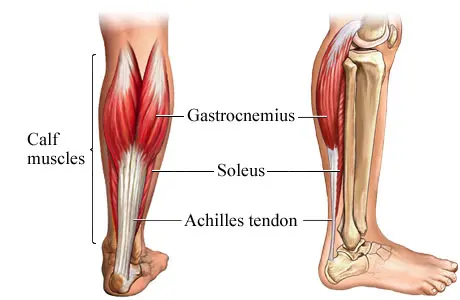
The Best Old-School Calf Workouts
Here are three classic old-school calf building workouts to try. Each one was either used by a famous golden era bodybuilder or inspired by one. If you need to add mass to your lower legs, any of these awesome workouts will get the job done!
Before you start, spend a few minutes warming up to prepare your muscles and prevent injury. A few minutes of easy cardio, followed by some dynamic stretching and a couple of light sets of each exercise should be sufficient.
#1. Old-School Calf Workout
As a young bodybuilder, Arnold Schwarzenegger had very small calves. In fact, it was the reason he didn’t win some of his earlier competitions. To hide this problem, Arnie was frequently pictured standing in knee-deep water!
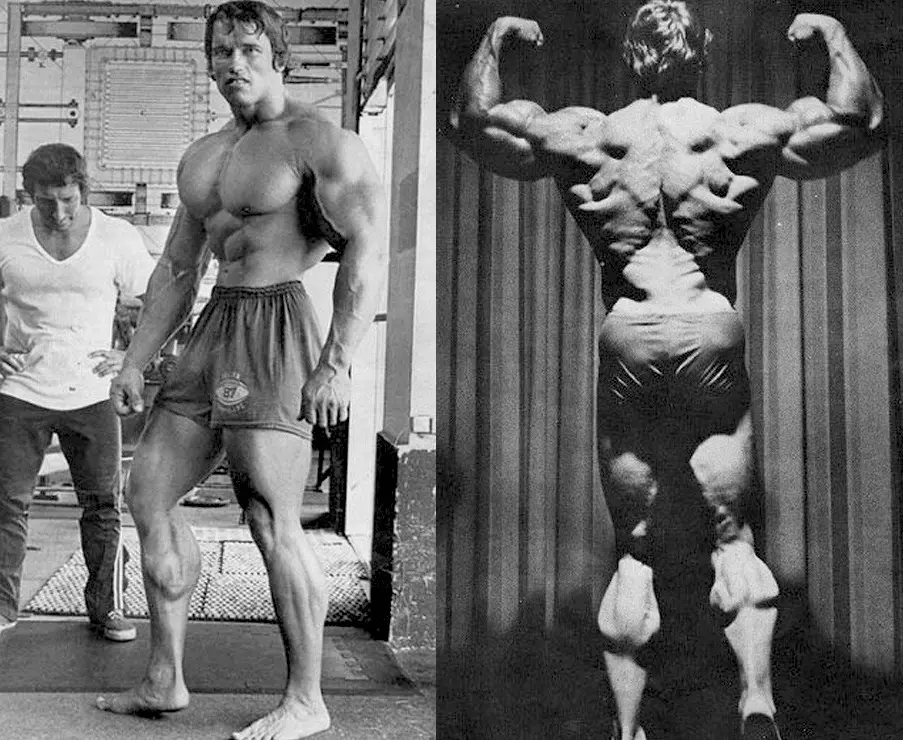
To face this problem, the Austrian Oak used to cut the bottoms off his workout pants so his calves were always on show. This was a source of embarrassment which motivated him to train is lower body harder and more often. This approach helped Arnie build amazing calves, and this workout is inspired by him.
Do this workout 2-3 times a week to shock your calves into new growth.
- Donkey calf raises: 5 sets of 15-20 reps
- Standing calf raises: 5 sets of 10-15 reps
- Seated calf raises: 5 sets 10-15 reps
Exercise descriptions
1.1 Donkey calf raises
This old-school calf exercise was one of the Terminator’s all-time favorites. It takes your ankles and calves through a large range of motion to provide a deep stretch and pump. Doing this exercise may raise a few eyebrows at the gym, but when your calves start to grow faster than ever before, you’ll be glad you did it.
How to do it:
- Stand with the balls of your feet on a 4-6″ block, so your heels are free to move.
- Keeping your legs straight, lean forward, and brace your arms against a bench or dumbbell rack. Ask your training partner to sit astride your hips.
- Lower your heels down toward the floor as far as possible, and then rise up on to your tiptoes. Repeat for the prescribed number of reps.
Tips:
- Do not let your partner sit on your lower back. This could lead to injury.
- You can also do this exercise on your own, wearing a chin/dip belt for resistance.
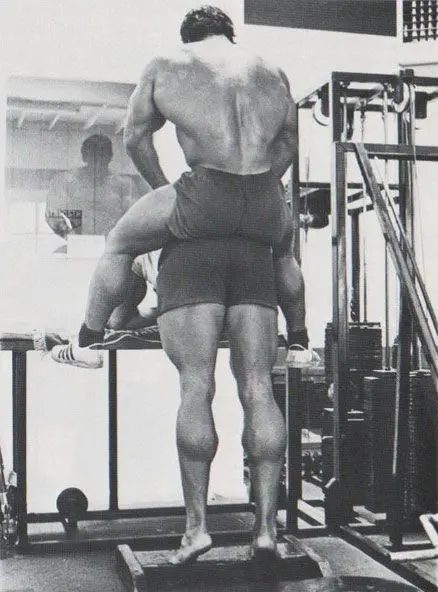
1.2 Standing calf raises
This is a classic calf mass-building exercise. Your calf muscles are very strong, so don’t be afraid to go heavy. Arnie reportedly worked up to doing sets with 1000 lbs. in this exercise!
How to do it:
- Adjust the height of the machine and step onto the footrest. Place the balls of your feet on the edge, so your heels are free to move up and down.
- Place your shoulders under the pads and stand up. Brace your abs and lock your knees.
- Rise up onto your tiptoes and then lower your heels as far down toward the floor as you can. Pause for a second at the top and the bottom of each rep to maximize muscle tension.
Tips:
- Keep your core braced to maintain the stability of your spine. This is especially important if you are using heavyweights.
- Do not bounce out of the bottom of your reps. Doing so could lead to a torn Achilles tendon.
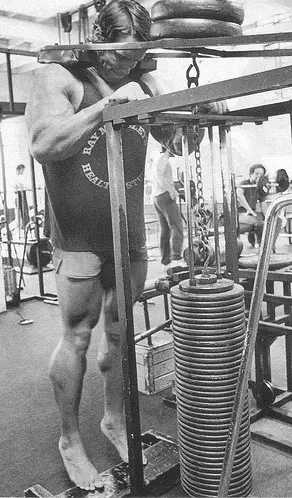
1.3 Seated calf raises
While your soleus is involved in all calf exercises, it’s especially active when your knees are bent. Working your soleus separately is not always necessary. Still, legendary bodybuilder Arnold Schwarzenegger almost always finished his calf workouts with this exercise.
How to do it:
- Sit on the calf raise machine so that the balls of your feet are on the footrest.
- Place your legs under the thigh pads and unrack the weight.
- Push up onto your tiptoes and then lower your heels down as far as you can. Continue for the prescribed number of reps.
Tips:
- Make sure the leg pad is across the tops of your knees. It may be painful if you have it across your thighs.

#2. Old-School Calf Workout
In the very old days of bodybuilding, strength training machines like standing and seated calf raises were scarce. And yet, despite this, the champions of the time still built impressive lower legs. This machine-free calf workout is ideal for home exercisers and anyone who wants to train their calves even in a gym with no calf raise machines. All you need is some free weights.
Do this workout twice per week on nonconsecutive days, e.g., Monday and Thursday.
- Single leg calf raises: 4 sets of 12-15 reps
- Goose step: 4 sets of as far as possible
- Ankle jumps: 4 sets of 50 reps
Exercise descriptions
2.1 Single leg calf raises
No calf raise machine? No problem! This exercise is every bit as effective, and, best of all, you just need a step and a dumbbell to do it.
How to do it:
Level Up Your Fitness: Join our 💪 strong community in Fitness Volt Newsletter. Get daily inspiration, expert-backed workouts, nutrition tips, the latest in strength sports, and the support you need to reach your goals. Subscribe for free!
- Stand on a 4-6″ high step. Stand on one leg with the ball of your foot on the edge, and your heel free to move up and down. Cross your ankles and use your hands for balance.
- Keeping your supporting knee straight, rise up onto your tiptoes and then lower your heel down toward the floor.
- Continue for the prescribed number of repetitions and then change legs.
Tips:
- Hold a dumbbell in one hand to make this exercise harder.
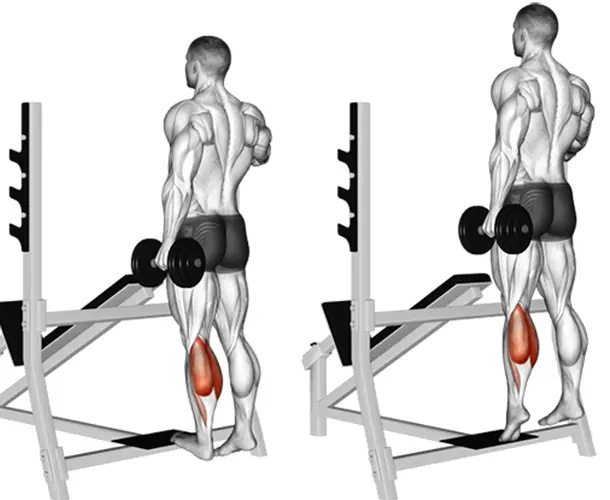
2.2 Goose step
Goose steps are a classic old-school calf exercise. They’re so old-school that most modern exercisers have never seen it before! Painful but effective, this exercise IS unusual, but you’ll love the way it makes your calves grow.
How to do it:
- Hold a heavy dumbbell in each hand or rest a barbell on your shoulders.
- Rise up onto your tiptoes than then take a walk around your training area. Do not let your heels touch the floor.
- Keep going for as long as you can. Your set is finished when you can no longer keep your heels off the ground.
Tips:
- Use wrists straps, so your grip doesn’t fail before your calves.
2.3 Ankle jumps
The final exercise in this old-school calf workout is explosive and athletic. Look at the calves on people who do a lot of sprinting and jumping; they’re usually big and strong. This exercise mimics this type of activity.
How to do it:
- Stand with your feet together and your hands by your side.
- Keeping your knees as straight as possible, jump up and down on the spot by pushing off your toes. Do not let your heels touch down.
- Continue for the prescribed number of reps.
Tips:
- Jump from side to side to work the lateral (side) aspect of your calves.
- Too easy? Hop on one leg instead or hold dumbbells in your hands.
#3. Old-School Calf Workout
Tom Platz, known as the Golden Eagle, had arguably the best legs in the history of bodybuilding. His quad and hamstring development were incredible, and he was also known for his phenomenal squatting strength.
But Platz didn’t neglect his lower legs, and his calves were every bit as impressive as his thighs. This old-school calf workout is inspired by Tom Platz and includes his favorite lower leg exercises.
Do this workout once or twice per week as required.
- Standing calf raises: 3 sets of 10-15 reps
- Seated calf raises: 3 sets of 10-15 reps
- Leg press calf raises: 3 sets of 10-15 reps
- Hack squat machine calf raises: 3 sets of 10-15 reps
Exercise descriptions
3.1 Standing calf raises
As explained in workout #1.
3.2 Seated calf raises
As explained in workout #1.
3.3 Leg press calf raises
This exercise is a cross between donkey calf raises and standing calf raises. It hits your calves from a unique angle, which could help trigger new muscle growth.
How to do it:
- Load up the leg press and climb aboard. Place the balls of your feet on the edge of the footrest and then straighten your legs.
- Point your toes and then flex your ankles as far as you can. Continue for the prescribed number of reps.
- Bend your legs and carefully put the weight down at the end of your set.
Tips:
- Keep your knees locked out throughout your set.
- Take care that your toes won’t slip off the edge of the footrest.
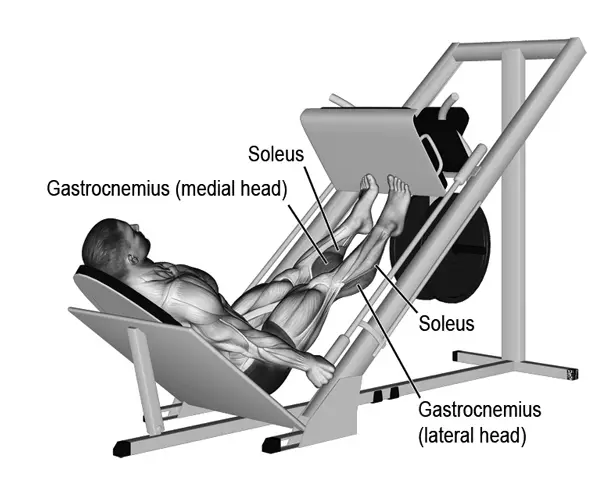
3.4 Hack squat machine calf raises
This exercise is very similar to regular standing calf raises, but, according to Platz, it works your calves from a slightly different angle, which is crucial for building bigger muscles. It’s also an excellent way to increase training volume without having to resort to doing more sets of the same old exercises.
How to do it:
- Face the backrest of your hack squat machine. Place your shoulders beneath the pads and the balls of your feet on the edge of the footrest. Straighten your legs and lift the weight.
- Keeping your core tight and your knees straight, push up onto your tiptoes, and then lower your heels down as far as you can.
- Keep going until you have completed all the prescribed reps.
Tips:
- Brace your core to keep your spine stable.
- Keep your knees locked out throughout your set.
Important calf training tips
Use these tips to get the best results from your calf-building workouts.
1. Use a full range of motion for each and every rep
Rise up as high as you can onto your tiptoes, and then lower your heels down as far as your flexibility allows. This increases time under tension and muscle activation, which are both crucial elements for maximal muscle growth (1).
2. Use a slow, controlled tempo
All types of calf raise will be more productive if you avoid using momentum to lift the weight. Take two seconds to rise up and two seconds to lower back down.
3. End your sets with partial reps
Full range reps should make up the bulk of your calf training, but partial reps are useful for getting a big pump and finishing off any untapped muscle fibers. Do your set as usual and then, on reaching failure, just pulse up and down an inch or two in the middle of your normal range of motion. Use this intensifying on the last set of each exercise only.
4. Try turning your feet in and out to target different parts of your calves
Turning your feet in may increase outer calf development, while turning your feet out may increase inner calf development. Use this technique on standing calf raises.
5. Work your calves every time you train
If you want to shock your calves into growing, do five sets of standing calf raises at the start of every workout, and five sets of seated calf raises at the end. Do this every time you hit the gym – even on upper body days.

Frequently asked questions
Do you have any questions? We’ve got the answers! If you can’t find the answer you want below, drop us a line in the comments section, and we’ll get back to you as soon as we can.
How often should I train my calves?
That’s a tricky question to answer, as some old-school bodybuilders only trained their calves once a week, while others, like Arnold, used to train them six-times a week! If your calves aren’t growing, training more often may help. So, if you are currently working your lower legs twice a week, and you aren’t getting the results you want, add another workout.
Can I train my calves in bare feet?
Yes! A lot of old-school bodybuilders used to train their calves in bare feet. They believed that, with no shoes to support their feet, their calves had to work harder. Before you whip off your shoes and start doing calf raises, check with your gym that they are okay with barefoot training. Some may have issues regarding hygiene or health and safety.
Can I do gym and home workouts for my calves during the same week?
Most definitely. This is actually an excellent idea. Train your calves with your legs 1-2 times per week, and then do 1-2 home workouts to boost calf growth. Old-school calf workout #2 is ideal for home training.
Is calf size and shape genetic?
Genetics play a role in the size and shape of every muscle – not just your calves. If you train hard, eat right, and your calves still aren’t growing, your genetics could be the problem.
That’s why some bodybuilders resort to calf implants. However, no matter what your genetics are like, you can still make your calves bigger if you work hard enough.
How big should my calves be?
Not sure how else to say this – the old school guys believed that your calves, neck, and biceps should all measure the same. If this still doesn’t make sense just delete this question/answer. Thanks!
According to some old-school bodybuilders, your calves, arms, and neck should all be roughly the same size, so if your biceps measure 16″, your calves and neck should too. While you might not be able to achieve this standard exactly, it’s a good target for most people.
Wrapping-up
A lot of people think they can’t build big calves, but in most cases, that’s because they haven’t really tried! It takes effort, determination, and persistence to build impressive calves – more than a couple of sets of calf raises at the end of your leg workout, that’s for sure.
Stop hoping your calves will grow. Instead, prioritize your lower legs and work them hard and often with the best old-school calf workouts. In time, your calves will grow and could even become your most impressive muscle group.
References
1- Schoenfeld, Brad J. (2010-10). “The mechanisms of muscle hypertrophy and their application to resistance training”. Journal of Strength and Conditioning Research. 24 (10): 2857–2872. doi:10.1519/JSC.0b013e3181e840f3. ISSN 1533-4287. PMID 20847704. https://www.ncbi.nlm.nih.gov/pubmed/20847704



